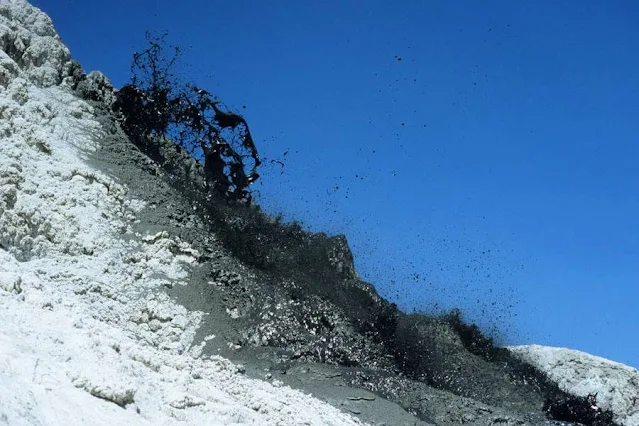'Mountain of God' the Most Unique Volcano
Ol Doinyo Lengai, known as the "Mountain of God" by the Maasai people, is a unique and active volcano located in the Gregory Rift, within the East African Rift Valley in Tanzania.
There’s no competition – the most Unique volcano in the world is definitely in Tanzania. It's the only known volcano in the world that erupts carbonatite lava in historical times. This type of lava is rich in sodium and potassium carbonates, rather than silica, which gives it unique chemical and physical properties. Over time, the black or dark brown lava turns white upon cooling due to its chemical composition.
The volcano stands at an elevation of approximately 2,890 meters (9,482 feet). Its summit features a light-colored ash cone and crater where recent eruptive activity has been observed. Ol Doinyo Lengai, a Maasai name, translates to "Mountain of God."
 |
| Lava Fountain Frozen During
Eruption Unlike Most Lavas, This is a Carbonate Rather Than a Sillicate
and Erupts. Photo: © Carsten Peter & Tineke Speelman |
Ol Doinyo Lengai is notable for its natrocarbonatite lava, which is cooler and more fluid than the silicate lavas typical of other volcanoes. This lava erupts at temperatures around 500-600 degrees Celsius (930-1,100 degrees Fahrenheit), making it the "coolest" lava on Earth. It’s so cold in fact that it’s almost always black, as there’s not enough heat radiating away from it to make it look red.
The volcano has been periodically active with records of eruptions dating back to the 1880s. Recent activity includes reports of eruptions, lava flows, and thermal anomalies detected through satellite imagery and ground sensors, with activity noted as recently as 2024.
 |
| Ol Doinyo Lengai lava flow, The natrocarbonatite lava looks like fluid black oil and it turns white when in contact with objects full of moisture. |
The ultimate source of these carbonatite lavas is still hotly debated — and to make it more complicated, Ol Doinyo Lengai doesn’t even erupt the usual carbonatite (if you can call any carbonatite “usual”) lava. Not only that, but carbonatites might be a good source for mining rare earth elements, so understanding how they form is going to become increasingly important.
Carbonatites are magma that are full of alkali elements — calcium, sodium, sometimes potassium — along with abundant carbon dioxide. Why is that odd? Most terrestrial magma is silicate, that is to say that much of the magma is made from bonded chains of silicon and oxygen. Even what we’d call “low silica” magma like basalt has 45 weight percent silica (SiO₂) and “high silica” magma like rhyolite can be over 70 weight percent silica.
Now, these carbonatite magma (made mainly of CaCO₃ — calcium carbonate) are so saturated in alkali elements that they only have a few to less than a quarter weight percent silica! Instead, the bulk of the mass of the magma is composed on mainly calcium, CO₂ (and in the case of Ol Doinyo Lengai, sodium).
 |
| Aerial view of the crater at Ol Doinyo Lengai volcano. The crater is filled with dry lava that has turned white due to its chemical composition. Photo: Guido Simonetti |
This has real consequences for the behavior of the magma. Those chains of silica in silicate magma are what give it some of its strength, where even the runniest basaltic lava is, in fact, quite viscous — remember the sampling a basaltic lava flow at Tolbachik to see how sticky basalt can be. However, without the chains of silica to give the magma structure, carbonatite magma can have much lower viscosity, allowing for the strange “garden hose” eruptions that exemplify activity in the crater of Oldoinyo Lengai.
The lack of structure and its composition also allows for carbonatite magma to erupt at much cooler temperatures than silicate magma. Your run-of-the-mill basalt might erupt at 1100-1200ºC, but carbonatite lava erupts at ~480-590ºC. That is likely a few hundred degree cooler than even the coolest silicate magmas (rhyolite).
 |
| Ol Doinyo Lengai volcano lava. Photo: photovolcanica.com |
Carbonatite lavas even weather differently than silicate lavas. They are composed on carbonate minerals like calcite (or even strangest minerals like nyerereite and gregoryite), so when exposed to water or even humid atmosphere, they break down quickly. This gives Oldoinyo Lengai its unique coloration, where dark carbonatite lavas erupt black to grey but after cooling at weather, appear stark white.
Most lava flows across a flat plateau at speeds rarely exceeding 10 kilometers per hour (about 6 miles per hour), meaning that it’s not difficult to simply step out of its way. Ol Doinyo Lengai’s lava can easily outpace a human’s running pace – so it’s a good thing it rarely undergoes a powerful, voluminous eruption.
 |
| Aerial view of Ol Doinyo Lengai or mountain of god northern Tanzania East Africa |
The eruptions and lava flows from Ol Doinyo Lengai contribute to the landscape around Lake Natron, a nearby soda lake known for its high alkalinity, which is partly due to the minerals from the volcano.
 |
| Explosion of carbonatite lava on Ol Doinyo Lengai volcano. Photo: photovolcanica.com |
The unique composition of its lava provides valuable insights into the geological processes within the Earth's mantle, particularly how carbonatite magmas form and evolve. This has made Ol Doinyo Lengai a focal point for volcanologists and geologists interested in magma chemistry and volcanic behavior.








%20(1).webp)